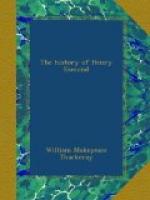He ran to the curate’s house in Kensington Mall, and asked for Mr. Bates, the name the Prince went by. The curate’s wife said Mr. Bates had gone abroad very early in the morning in his boots, saying he was going to the Bishop of Rochester’s house at Chelsey. But the Bishop had been at Kensington himself two hours ago to seek for Mr. Bates, and had returned in his coach to his own house, when he heard that the gentleman was gone thither to seek him.
This absence was most unpropitious, for an hour’s delay might cost a kingdom; Esmond had nothing for it but to hasten to the “King’s Arms,” and tell the gentlemen there assembled that Mr. George (as we called the Prince there) was not at home, but that Esmond would go fetch him; and taking a General’s coach that happened to be there, Esmond drove across the country to Chelsey, to the Bishop’s house there.
The porter said two gentlemen were with his lordship, and Esmond ran past this sentry up to the locked door of the Bishop’s study, at which he rattled, and was admitted presently. Of the Bishop’s guests one was a brother prelate, and the other the Abbe G——.
“Where is Mr. George?” says Mr. Esmond; “now is the time.” The Bishop looked scared: “I went to his lodging,” he said, “and they told me he was come hither. I returned as quick as coach would carry me; and he hath not been here.”
The Colonel burst out with an oath; that was all he could say to their reverences; ran down the stairs again, and bidding the coachman, an old friend and fellow-campaigner, drive as if he was charging the French with his master at Wynendael—they were back at Kensington in half an hour.




